Intel Architecture Day 2021: Alder Lake, Golden Cove, and Gracemont Detailed
by Dr. Ian Cutress & Andrei Frumusanu on August 19, 2021 9:00 AM EST
This week Intel held its annual Architecture Day event for select press and partners. As with previous iterations, the company disclosed details about its next generation architectures set to come to the market over the next twelve months. Intel has promised the release of its next-generation consumer and mobile processor family, Alder Lake, to come by the end of the year and today the company is sharing a good number of details about the holistic design of the chips as well as some good detail about the microarchitectures that form this hybrid design: Golden Cove and Gracemont. Here is our analysis of Intel’s disclosure.
Alder Lake: Intel 12th Gen Core
As mentioned in previous announcements, Intel will launch its Alder Lake family of processors into both desktop and mobile platforms under the name of Intel’s 12th Gen Core Processors with Hybrid Technology later this year. This is Intel’s second generation hybrid architecture built on Intel 7 process node technology. The hybrid design follows Intel Lakefield designs for small notebooks launched last year. The nature of a hybrid design in Intel nomenclature involves having a series of high ‘Performance’ cores paired with a number of high ‘Efficiency’ cores. Intel has simplified this into P-core and E-core terminology.
For Alder Lake, the processor designs feature Performance cores based on a new Golden Cove microarchitecture, and Efficiency cores based on a new Gracemont architecture. We will cover both over the course of this article, however the idea is that the P-core is preferential for single threaded tasks that require low latency, and the E-core is better in power limited or multi-threaded scenarios. Each Alder Lake SoC will physically contain both, however Intel has not yet disclosed the end-user product configurations.
Each of the P-cores has the potential to offer multithreading, whereas the E-cores are one thread per core. This means there will be three physical designs based on Alder Lake:
- 8 P-core + 8 E-core (8C8c/24T) for desktop on a new LGA1700 socket
- 6 P-core + 8 E-core (6C8c/20T) for mobile UP3 designs
- 2 P-core + 8 E-core (2C8c/12T) for mobile UP4 designs
Intel typically highlights UP4 mobile designs for very low power installs, down to 9 W, whereas UP3 can cover anything from 12 W to 35 W (or perhaps higher), but when asked about the power budgets for these processors, Intel stated that more detail will follow when product announcements are made. Intel did confirm that the highest client power, presumably on the desktop processor, will be 125 W.
Highlighted in our discussions is how modular Intel has made Alder Lake. From a range of base component options, the company mixed and matched what it felt were the best combination of parts for each market.
Here it shows that four E-cores takes up the same physical space as one P-core, but also that the desktop hardware will at most have 32 EUs (Execution Units) for Xe-LP graphics (same as the previous generation), while both of the mobile processors will offer 96 physical EUs that may be disabled down based on the specific line item in the product stack.
All three processors will feature Intel’s next generation Gaussian Neural Accelerator (GNA 3.0) for minor low power AI tasks, a display engine, and some level of PCIe, however the desktop processor will have more. Only the mobile processors will get an Image Processing Unit (IPU), and Thunderbolt 4 (TBT), and here the big UP3 mobile processor gets four ports of Thunderbolt whereas the smaller UP4 will only get two. The desktop processor will not have any native Thunderbolt connectivity.
A bit more info on the Desktop Processor IO and Interconnect
We’ll cover a bit more detail about the core designs later in this article, but Intel did showcase some of the information on the desktop processor. It confirmed explicitly that there would be 16 total cores and 24 threads, with up to 30 MB of non-inclusive last level/L3 cache.
In contrast to previous iterations of Intel’s processors, the desktop processor will support all modern standards: DDR5 at 4800 MT/s, DDR4-3200, LPDDR5-5200, and LPDDR4X-4266. Alongside this the processor will enable dynamic voltage-frequency scaling (aka turbo) and offer enhanced overclocking support. What exactly that last element means we’re unclear of at this point.
Intel confirmed that there will not be separate core designs with different memory support – all desktop processors will have a memory controller that can do all four standards. What this means is that we may see motherboards with built-in LPDDR5 or LPDDR4X rather than memory slots if a vendor wants to use LP memory, mostly likely in integrated small form factor designs but I wouldn’t put it past someone like ASRock to offer a mini-ITX board with built in LPDDR5. It was not disclosed what memory architectures the mobile processors will support, although we do expect almost identical support.
On the PCIe side of things, Alder Lake’s desktop processor will be supporting 20 lanes of PCIe, and this is split between PCIe 4.0 and PCIe 5.0.
The desktop processor will have sixteen lanes of PCIe 5.0, which we expect to be split as x16 for graphics or as x8 for graphics and x4/x4 for storage. This will enable a full 64 GB/s bandwidth. Above and beyond this are another four PCIe 4.0 lanes for more storage. As PCIe 5.0 NVMe drives come to market, users may have to decide if they want the full PCIe 5.0 to the discrete graphics card or not
Intel also let it be known that the top chipset for Alder Lake on desktop now supports 12 lanes of PCIe 4.0 and 16 lanes of PCIe 3.0. This will allow for additional PCIe 4.0 devices to use the chipset, reducing the number of lanes needed for items like 10 gigabit Ethernet controllers or anything a bit spicier. If you ever thought your RGB controller could use more bandwidth, Intel is only happy to provide.
Intel did not disclose the bandwidth connectivity between the CPU and the chipset, though we believe this to be at least PCIe 4.0 x4 equivalent, if not higher.
The Alder Lake processor retains the dual-bandwidth ring we saw implemented in Tiger Lake, enabling 1000 GB/s of bandwidth. We learned from asking Intel in our Q&A that this ring is fully enabled regardless of whether the P-cores or E-cores are being used – Intel can disable one of the two rings when less bandwidth is needed, which would save power, however based on previous testing this single ring could end up drawing substantial power compared to the E-cores in low power operation. (This may be true in the mobile processors as well, which would have knock on effects for mobile battery life.)
The 64 GB/s of IO fabric is in line with the PCIe 5.0 x16 numbers we saw above, however the 204 GB/s of memory fabric bandwidth is a confusing number. Alder Lake features a 128-bit memory bus, which allows for 4x 32-bit DDR5 channels (DDR5 has two 32-bit channels per module, so 2 modules still), however in order to reach 204 GB/s in that configuration requires DDR5-12750; Intel has rated the processor only at DDR5-4800, less than half that, so it is unclear where this 204 GB/s number comes from. For perspective, Intel’s Ice Lake does 204.8 GB/s, and that’s a high-power server platform with 8 channels of DDR4-3200.
This final slide mentions TB4 and Wi-Fi 6E, however as with previous desktop processors, these are derived from controllers attached to the chipset, and not in the silicon itself. The mobile processors will have TBT integrated, but the desktop processor does not.
This slide also mentions Intel Thread Director, which we want to address on the next page before we get to the microarchitecture analysis.


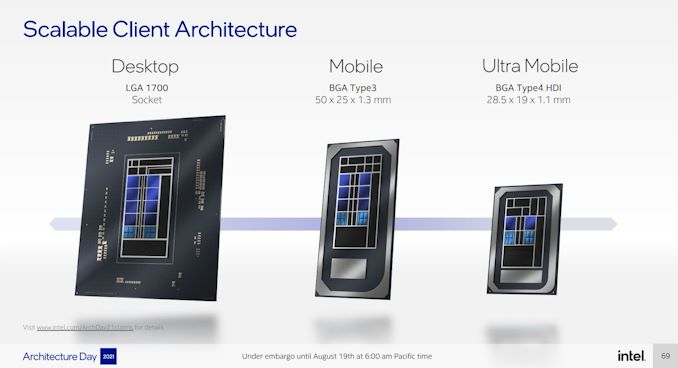

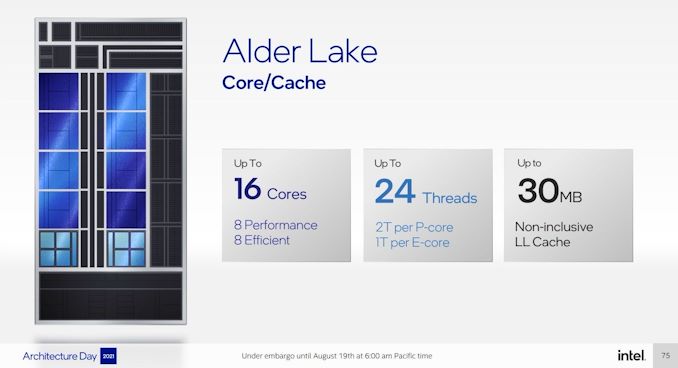
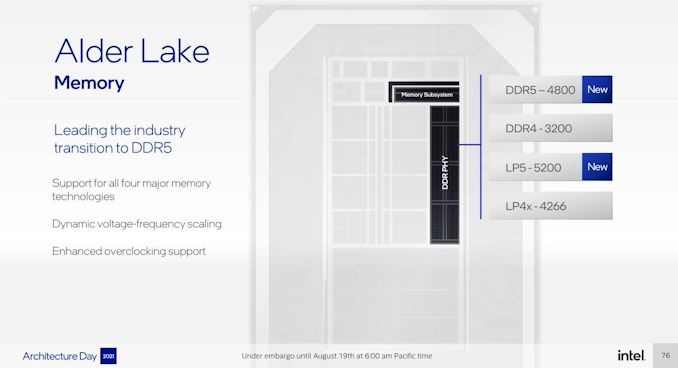
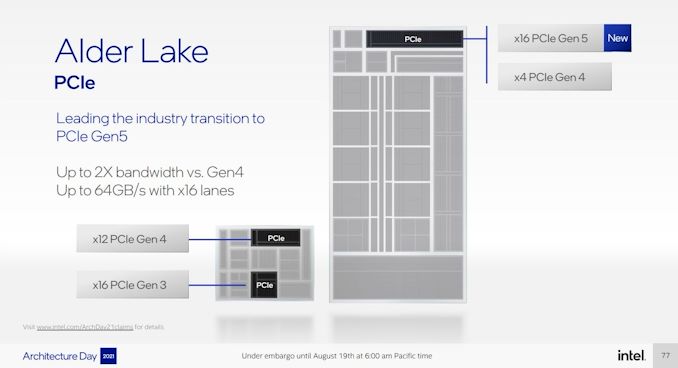
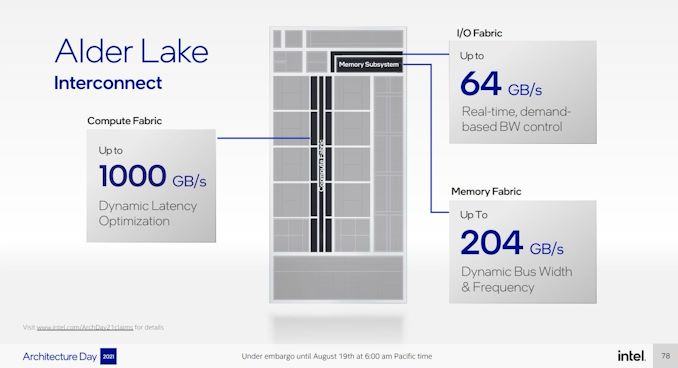
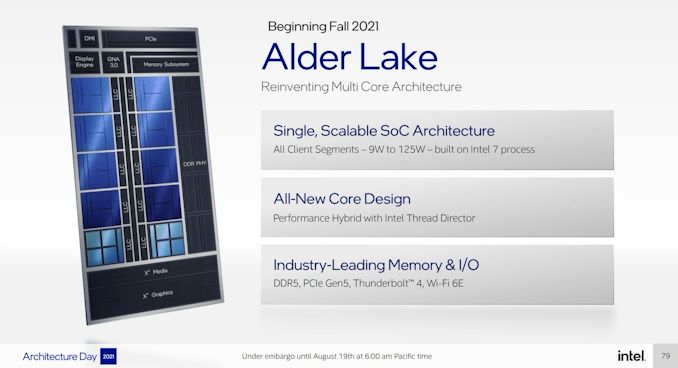








223 Comments
View All Comments
mode_13h - Thursday, August 19, 2021 - link
Indeed. But, remember that it's a Skylake from 2015, fabbed on Intel's original 14 nm node, and it's an integer workload they measured. If they measured vector or FPU workloads, the results would probably be rather different.Spunjji - Monday, August 23, 2021 - link
Indeed. Based on how Intel usually do their marketing, I'm not expecting anything revolutionary from those cores. Maybe I'll be surprised, but I'm expecting mild disappointment.mode_13h - Tuesday, August 24, 2021 - link
Having already bought into the "Atom" series at Apollo Lake, for a little always-on media streaming server, I'm already thrilled! Tremont was already a bigger step up than I expected.Spunjji - Tuesday, August 24, 2021 - link
Fair - I've just been a bit burned! Last time I used an Atom device was Bay Trail, and at the time there was a big noise about its performance being much better than previous Atom processors. The actual experience was not persuasive!Silver5urfer - Thursday, August 19, 2021 - link
Too many changes in the CPU x86 topology. They are making this CPU a heavily dependent one of the OS side with such insane changes to the Scheduler system, like P, E and then the Hyperthreading of P cores. On top of all this the DRAM system must be good else all that 19% big IPC boost will be wasted just like on Rocket Lake. Finally Windows 11 only ? dafaq.I have my doubts on this Intel IDT and the whole ST performance along with gaming SMT/HT performance. Until the CPU is out it's hard to predict the things. Also funny they are simply adding the older Skylake cores to the processor in a small format without HT, while claiming this ultra hybrid nonsense, seems like mostly tuned for a mobile processor than a Desktop system which is why there's no trash cores on the HEDT Sapphire Rapids Xeon. And which Enterprise wants to shift to this new nonsense of x86 landscape. On top we have Zen 4 peaking at 96Core 192T hyperbeast Genoa which also packs AVX512.
I'm waiting Intel, also AMD for their 3D V Cache Zen 3 refresh. Plus whoever owns any latest processors from Intel or AMD should avoid this Hardware like plague, it's too much of a beta product and OS requirements, DRAM pricing problems will be there for Mobos and RAM kits and PCIe5.0 is just damn new and has no usage at all right now It all feels just like Zen when AMD came with NUMA system and refined it well by the Zen 3. I doubt AMD will have any issue with this design. But one small good news is some competition ?
Silver5urfer - Thursday, August 19, 2021 - link
Also scalable lol. This design is peaked out at 8C16T and 8 small cores while Sapphire Rapids is at 56Cores 112T. AMD's Zen 4 ? 96C/192T lmao that battle is going to be good. Intel is really done with x86 is what I get from this, copying everything from AMD and ARM. Memory Interconnects, Big Little nonsense. Just release the CPU and let it rip Intel, we want to see how it works against 10900Ks and 5900Xs.mode_13h - Friday, August 20, 2021 - link
> Also funny they are simply adding the older Skylake cores> to the processor in a small format without HT
They're not Skylake cores, of course. They're smaller & more power-efficient, but also a different uArch. 3+3-wide decode, instead of 4-wide, and no proper uop cache. Plus, the whole thing about 17 dispatch ports.
If you back-ported these to 14 nm, they would lose their advantages over Skylake. If they forward-ported Skylake to "Intel 7", it would probably still be bigger and more power-hungry. So, these are different, for good reasons.
vyor - Friday, August 20, 2021 - link
I believe they have a uOP cache though?mode_13h - Saturday, August 21, 2021 - link
No, Tremont and Gracemont don't have a uop cache. And if Goldmont didn't, then it's probably safe to say that none of the "Atom" cores did.The article does mention that some aspects of the instruction cache make it sound a bit like a uop cache.
Silver5urfer - Saturday, August 21, 2021 - link
I see the only reason - Intel was forced to shrink the SKL and shove them in this designs because their node Fabs are busted. Their Rocket Lake is a giant power hog. Insane power draw. Intel really shined until 10900K, super fast cores, ultra strong IMC that can handle even 5000MHz and any DRAM. Solid SMT. High power but it's a worth trade off.With RKL, backport Intel lost - IMC leadership, SMT performance, ST performance (due to Memory latency) AND efficiency PLUS Overclockability. That was the time I saw Intel's armor cracking. HEDT was dead so was Xeon but the only reason Mainstream LGA1200 stood was super strong ring bus even on RKL.
Now FF to 10SF or Intel 7 whatever they call it. No more high speed IMC now even double whammy due to the dual ring system and the ring is shared by all the cores connected, I doubt these SKL cores can manage the highspeed over 3800MHz DDR4 RAM, which is why they are mentioning Dynamic Clocking for Memory, this will have Gearing memory system for sure. High amount of efficiency focus due to the Laptop market from Apple and AMD pressure. No more big core SMT/HT performance. Copying ARMs technology onto x86 is pathetic. ARM processors never did SMT x86 had this advantage. But Intel is losing it because their 10nm is a dud. Look at the leaked PL1,2,4 numbers. It doesn't change at all, they crammed 8 phone cores and still it's higher and higher.
Look at HEDT, Sapphire Rapids, tile approach, literally copied everything they could from AMD and tacked on HBM for HPC money. And I bet the power consumption would be insanely high due to no more phone cores cheating only big x86 real cores. Still they are coming back. At this point Intel would have released "Highest Gaming Performance" marketing for ADL, so far none and release is just 2 months. RKL had that campaign before 2 months and CFL, CML all of them had. This one doesn't and they are betting on I/O this time.
Intel has to show the performance. And it's not like AMD doesn't know this, which is why Lisa Su showed off a strong 15% gaming boost. And remember when AMD showcases the CPUs ? Direct benchmarks against Intel's top - 9900K, 10900Ks all over the place. No sign of 5900X or 5950X comparisons from Intel.